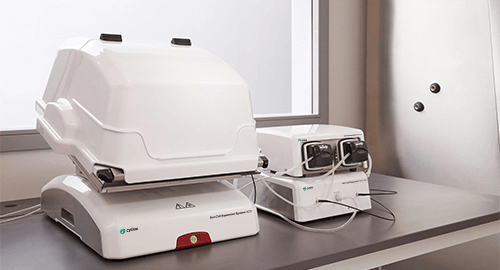Rocking platforms: A great idea that keeps getting better
Rocking platforms for single-use bioreactors were introduced in the late 1990’s as an alternative to stainless steel stirred-tank bioreactors. The design enabled non-invasive mixing and efficient gas exchange in a functionally closed environment and the basic principles haven’t changed much during the 20 years since Dr Vijay Singh’s patent was granted for the original apparatus. However, the demand for novel and personalized cell therapies has driven advances in technology and improvements in process control and although the Xuri™ Cell Expansion System is based on that first design, it is now widely used for the expansion of cells to target doses in highly regulated environments.
How do rocking bioreactors work?
A multilayer clear plastic cellbag bioreactor is mounted on to an adjustable rocking platform attached to the base of a Xuri™ Cell Expansion System and inflated. Culture medium and cells are then loaded in to the Cellbag™ bioreactor via ports on the bag surface. The system’s motorized base creates a gentle rocking motion that induces waves in the cell culture fluid to provide efficient mixing and gas transfer to respiring cells. Sensors enable remote monitoring of culture conditions such as dissolved oxygen, temperature, and pH while the rocking angle and speed of the platform can be adjusted to suit the needs of different cell types.
Why rocking is better than stirring
Gentle rocking not only keeps your cells in solution and ensures continuous non-invasive mixing of media but provides a highly effective method of transferring oxygen to maximize growth. The Xuri™ Cell Expansion System is also fully automated. It requires minimal manual intervention thereby increasing reproducibility between runs and reducing the possibility of operator error. Wave technology means no risk of contamination or cell damage from invasive impellers. Whether the process is autologous or allogeneic, the systems flexible working volumes of up to 25 L mean an entire cell culture is possible in a single bioreactor without the need for labor intensive transfers to other vessels under clean room conditions.
The main advantages of rocking bioreactors over stirred bioreactors are:
- Low sheer: Rocking is less likely to damage cells than stirred tanks.
- Non-invasive: No risk of contamination from impellers during mixing.
- Single-use: Ready-to-use components do not require cleaning, preparation, or sterilization prior to use.
- Wide working volume: No need for risky transfers regardless of culture scale.
- Cost efficient: Setup costs are lower than for steel tanks and automation does not require specialist skills
Always looking to improve
The Xuri™ Cell Expansion System is easily capable of producing > 1 × 107 cells/mL in working volumes up to 25 L. This is sufficient for reaching target therapeutic doses, however, we are continually searching for ways to improve and optimize cell expansion processes to support the increasing demand for cell therapies.
For example, we recently used a combination of experimental data and predictive modelling to see how the rocking rate and the rocking angle of the Xuri™ Cell Expansion System affected the expansion potential of T cells grown in Cellbag™ bioreactors. The results show that although the growth rate of T cells only moderately improved using the optimized rocking conditions, the overall impact on a complex manufacturing process and autologous patient sample processing can be significant. Optimization and automation of rocking angles and speed offer not only a greater yield of T cells, but also builds reliability into the culture process.
For more details on how to incorporate the Xuri™ Cell Expansion System into your CAR T cell manufacturing workflow, check out our application note.
